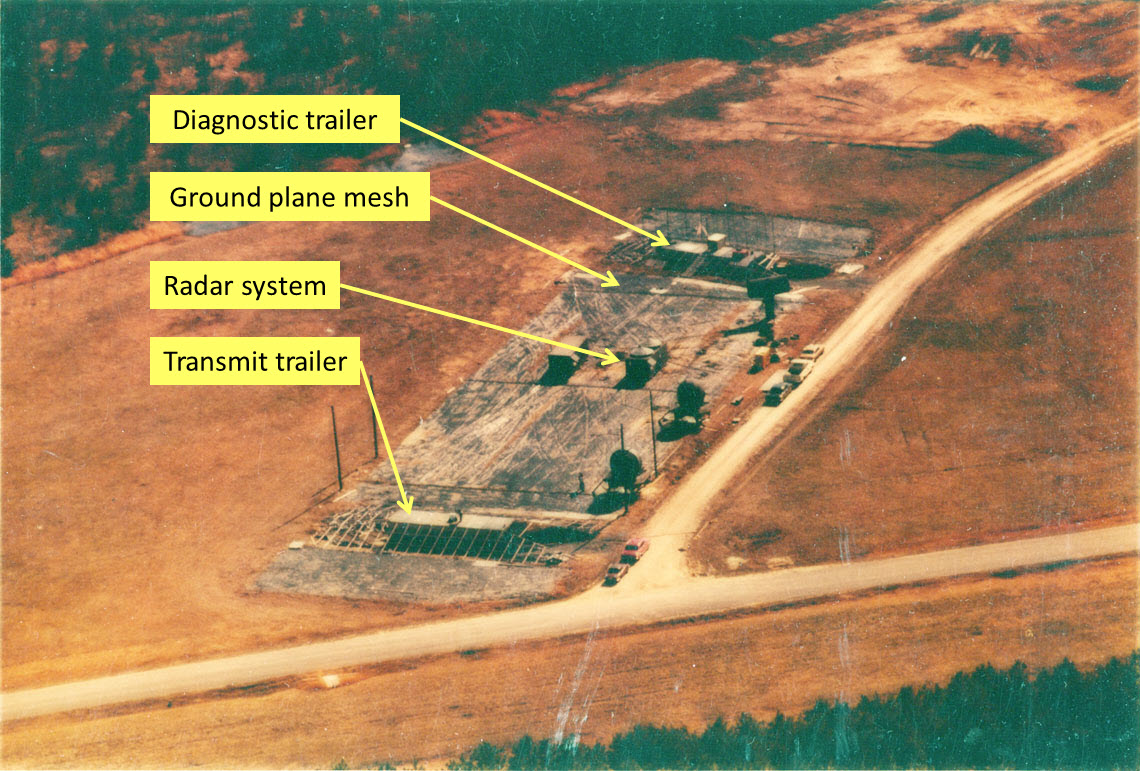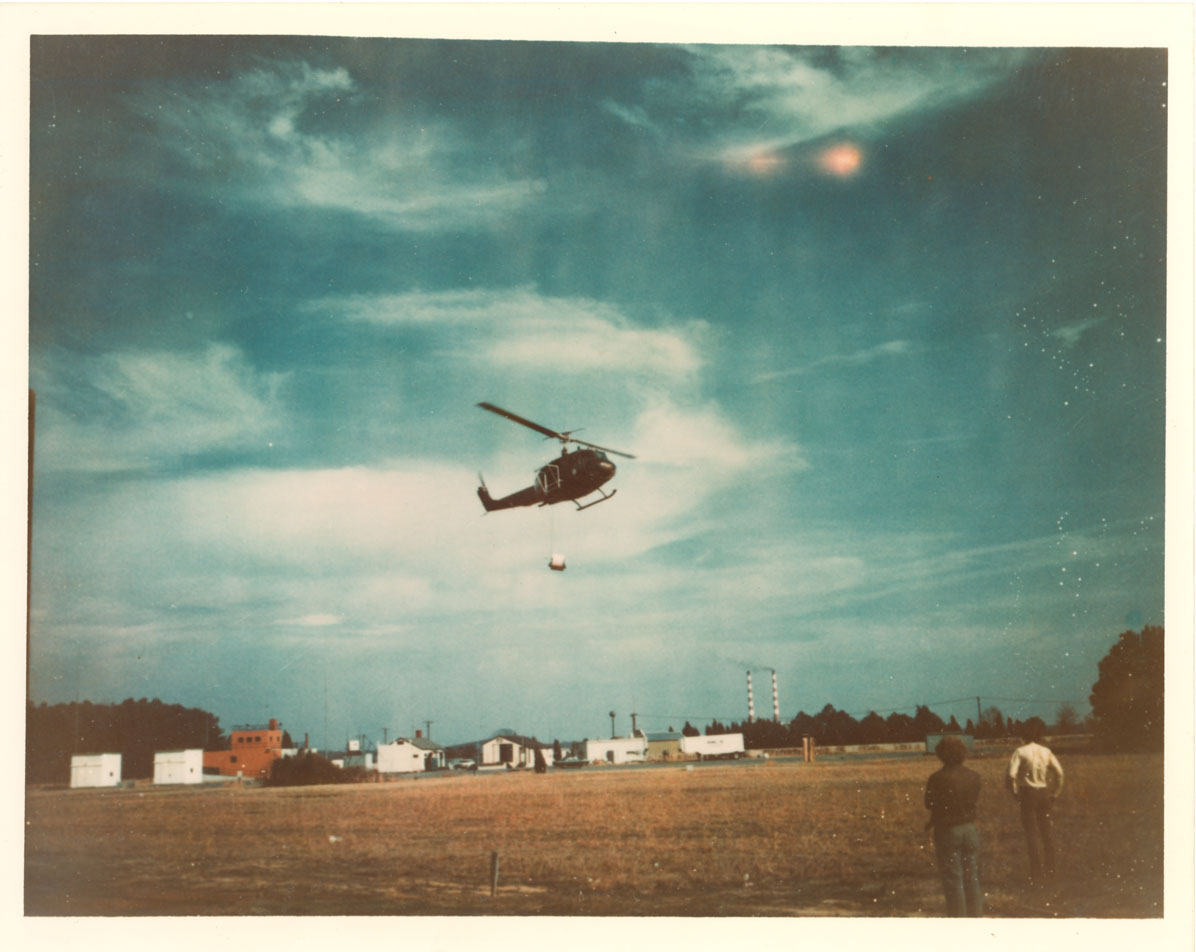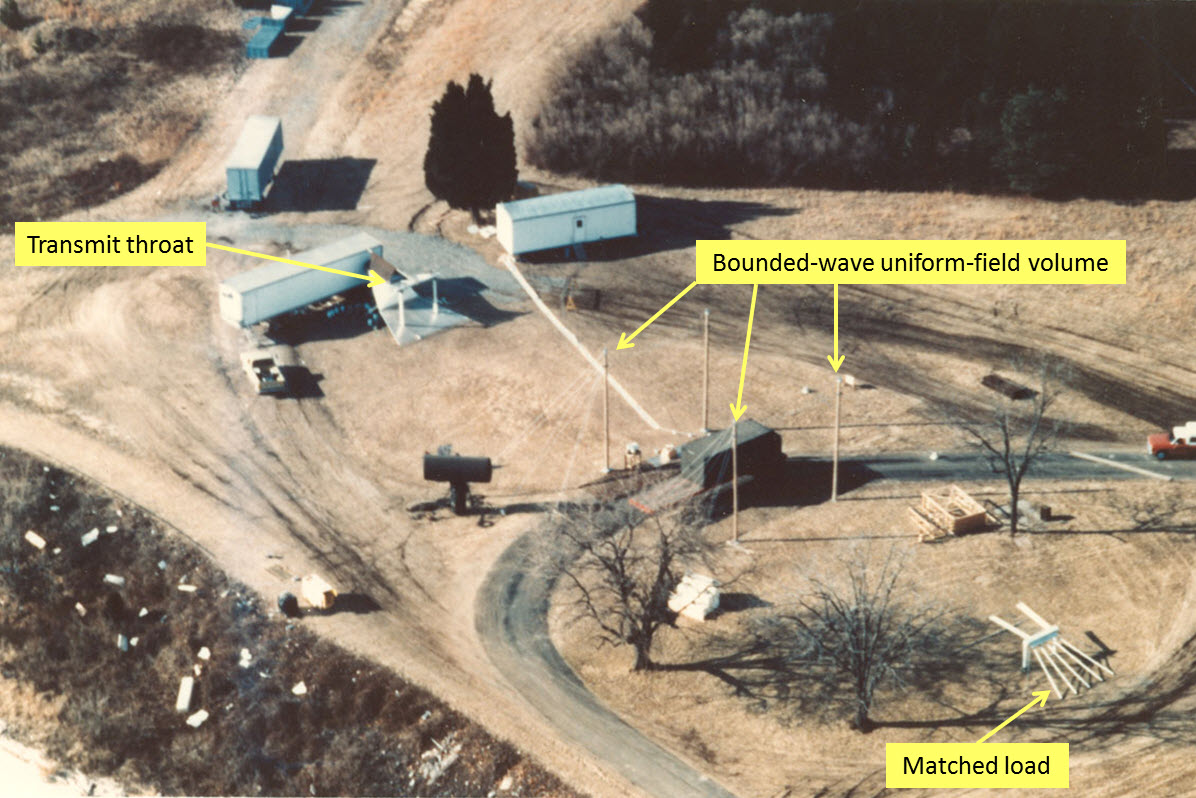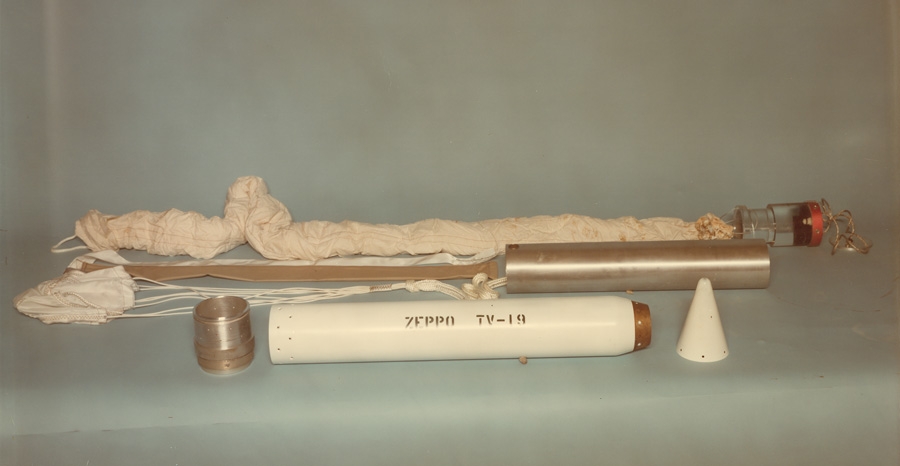Early Days of RF Weapons at Dahlgren
November 27, 2017
By: Stuart Moran and Ron Gripshover
Special Guest Writers
The Naval Surface Warfare Center, Dahlgren Division (NSWCDD), has a rich history of experience in electromagnetics. Since the 1960s, NSWCDD has been on the leading edge of electromagnetic (EM) exploration and application, both to enhance our understanding of EM spectrum impact on our own explosives and systems, and to develop innovative ways to use EM against enemy capabilities. This blog is a brief overview of NSWCDD’s achievements in an area that, in many ways, is coming of age now; an area that will play a prominent role in maintaining our maritime supremacy.
In 1962, the United States set off a large nuclear weapon above the Pacific. The blast created high-speed electrons in the upper atmosphere that formed oscillating electric fields over a large area of the Pacific. These fields were strong enough to damage electronics in Hawaii, 1000 miles away, and clearly demonstrated the effects of a nuclear electromagnetic pulse (EMP). Almost immediately the military began to consider ways to create such pulses without using nuclear weapons.
Dahlgren had been working on the Hazards of Electromagnetic Radiation to Ordnance (HERO) program since the late 1950s. In 1967, USS Forrestal (CV-59) was heavily damaged when electromagnetic interference from the ship’s radar created false signals and launched a Zuni rocket from a parked fighter jet. The rocket hit another jet (piloted by future Senator John McCain) and ignited the fuel. The fire spread to other aircraft causing a bomb to detonate, creating severe damage to the ship and the loss of over a hundred sailors. Dahlgren investigated problems like this and soon became the Navy’s leader in testing for electromagnetic interference on electronics as well as methods to control the problems. This became the Electromagnetic Vulnerability Program in the late 1960s.
In 1969, Dahlgren scientists briefed test results of a large amount of electronic failure and interference data observed on missiles, aircraft, and ground systems, particularly on the new solid-state components. This information influenced the Navy to begin quick-reaction programs at Dahlgren to look at vulnerabilities and fixes for Navy missiles. One of these projects, SEMI, Special Electromagnetic Interference, looked at missile seekers as they passed through ships’ radar during launch. The Navy also began to consider the potential of developing a high-power microwave weapon that might take advantage of similar vulnerabilities in enemy electronics.
In the early 1970s, Dr. Frank Rose in the Special Applications Branch and Robert (Bob) Hudson from the HERO and SEMI group, made many pitches to potential sponsors about the hazards of unintended EM radiation. Bob Hudson first pitched Navy system vulnerability to high-power electromagnetic pulses. Dr. Rose followed Hudson, stating he could develop high-power systems to exploit potential vulnerabilities of enemy electromagnetic systems. Together they made a successful team, which led to a number of efforts at Dahlgren.
The Special Applications Branch began studying ways to generate high-power oscillating electric fields that could be used as weapons to damage enemy electronics. These devices typically stored energy in a high-voltage capacitor and released the energy quickly using a spark-gap switch. This then drove oscillating currents on an antenna, causing it to radiate. These devices were basically high-power versions of the old spark-gap transmitters used in the early days of radio. Dahlgren began systematically testing the effects of high-power radio frequency (RF) pulses, ranging from a few to many RF cycles, against military electronics. This led to the development of improved methods of producing high peak powers using a wide range of technologies.
The early evolution of the branch and its people and expertise centered on three major programs: Special Effects Warhead (SEW) (1973–77); Zuni Expendable Pulsed Power Oscillator (ZEPPO) (1976–81); and Pulsed Power Technology (PPT) (1978–88). The first two are discussed here, and the PPT program will be covered in a later blog.
Special Effects Warhead (SEW) Program (1973–77)
NSWCDD began a two-phased program under Naval Air Systems Command and Defense Advanced Research Projects Agency sponsorship to determine and develop the potential to use non-nuclear electromagnetic sources to create EMP-like damage mechanisms. The first phase, the device technology phase, was a research and development (R&D) effort to determine the feasibility of creating intense pulses from small, compact sources. The second phase, the target vulnerability phase, assessed the vulnerability of U.S. and foreign electronics to EMP-type radiation. The group leading this effort was located in the remote northeast corner of the base, formerly the Rocket Land Range, to maintain a distance from explosives and gun ranges. The personnel offices were located in trailers near the present location of Building 1490. The early effort was led by Dr. Frank Rose; Dr. Ron Pollard; Dr. Ken Baile; and later by Walter Orsulak. Dr. Ron Gripshover was the chief scientist.
The premise of the effort was that the damage mechanism(s) of a nuclear EMP could be exploited by using non-nuclear electromagnetic sources, i.e., a special effects warhead. The SEW Program looked at the feasibility of constructing an electromagnetic warhead that could disable electronics beyond a normal hard-kill explosive range, as far as a mile away. Under the device technology phase, R&D efforts were initiated to investigate generating intense EM pulses from small compact sources.
These sources were largely made by the scientists, engineers and talented technicians using Plexiglas®, Mylar™, brass, copper, and copious amounts of epoxy. These devices were typically known as Hertzian oscillators and included L C oscillators, frozen wave generators, Ross circuits, vector inversion generators (spirals), transmission line oscillators, and Landecker rings. The devices were typically charged to hundreds of thousands of volts and fired with a spark gap switch, causing the energy to oscillate. The high-voltage fields and sparking caused the workers to make a sign for one of the buildings: “Science Fiction Department.” Understanding what was happening on the nanosecond timescale of a spark was difficult. They had the latest oscilloscopes (which cost more than a Cadillac) and used the most sensitive camera film, but were still barely able to capture the waveforms. They often had to make their own diagnostic tools as well.
The Hertzian-type devices were typically connected to a simple antenna and oscillated at relatively low frequency, usually below 100 Mhz. Higher frequencies were difficult because the systems had to be smaller and store less energy. Air breakdown was often the limiting power factor. Measuring the output field of these devices was difficult because of ground effects, so a 100-meter ground plane of welded wire was laid out in a field with semi-underground trailers at each end to house high-voltage generators and diagnostics as shown in the figure below. This came closer to an ideal measurement system. The sources often produced over a gigawatt of peak power and field strengths of several kV/m at the target sites.
We always had difficulty measuring exactly what these homemade systems would produce and radiate. Measurements were made at some distance (in the far field) and compared to theory. Since this was before the age of desktop computers, the influence of the ground was difficult to model and predict, so we decided to suspend magnetic field sensors below helicopters to get above-ground effects. These sensors were several feet across and were lowered well below the helicopter on ropes and cables while passengers inside took oscilloscope photographs of the received pulses. This worked fairly well as long as the sensor did not start swinging wildly, which happened on occasion. There was always someone ready to quickly cut the ropes if things got out of hand.

High voltage transmitter and field measurement range using a wire grid ground plane (located at present site of Building 1460).

Field measurements using an airborne B-dot probe (note power plant in distance).
A major thrust of the SEW Program was to better understand the effects of high fields on military electronics. Little information was available on the vulnerability of foreign or U.S. electronics, particularly entire systems. Since the transmitter devices being tested did not produce high enough fields to test against large targets (such as a Nike Hercules Radar System), a trailer-based RF impulse system, employing a Marx generator-driven L C oscillator charged to over a million volts, was constructed. This Transportable Oscillating Pulser System was connected to a large bounded wave structure that produced uniform fields over a region large enough to place an entire radar or missile system (illustrated below). The electric field emitted from the throat of this system was so high that the air would arc unless a special bag of insulating gas (sulfur hexafluoride) was used until the radiating structure became large enough to transition to the normal atmosphere. The system was similar to the Navy Ordnance Transient EMP Simulator constructed many years later at Pumpkin Neck.

Transportable Oscillating Pulsar System (TOPS)
Under the SEW second phase, an effort was pursued to assess the vulnerability of Navy electronics as well as foreign and domestic radar and/or missile systems. Since many important target systems were not available for testing, much of the vulnerability information was obtained from U.S. electronics, and estimates were then made for foreign systems. In addition to the tests done at Dahlgren, pulsers were also constructed in mobile trailers that could be transported to other sites for testing against simulated or actual targets. The Mobile Oscillating Pulser System (MOPS) was an example that was carried to test sites, such as China Lake, to perform tests against radars and simulated foreign systems.
Frank Rose liked to demonstrate what the fields would do by walking out into the antenna region holding a diode. When the system fired, it shorted the diode, which could be measured with an ohm meter. This impressed visitors, but the real proof was what the components did inside a working system.
A key requirement for the SEW Program was to demonstrate enforceable target vulnerability, which means that a high percentage of the time a large percentage of the targets are affected. One important finding was the broad difference between an electromagnetic safety concern—where a 1% vulnerability was far too great—and a weapon concern—where a 10% vulnerability was not good enough. The field strengths between the safety requirements and weapon requirements often were many orders of magnitude apart.
The SEW Program looked at many types of electronic component, subsystem, and complete system vulnerabilities. As a result, energy tables for burnout effects were developed. Subsequently, Dahlgren performed numerous field tests against radar and communication systems between 1973 and 1978, and funded component and subsystem testing on missiles.
Zuni Expendable Pulsed Power Oscillator (ZEPPO) Program (1976–81)
Prior to the completion of the SEW Program, two spin-off efforts were initiated as logical technical outgrowths of the program: ZEPPO and Pulsed Power Technology. The Pulsed Power Program will be discussed in a later blog.
The SEW concept relied on single-shot, very high-peak power EM pulses, typically generated with spark-gap-initiated Hertzian devices. Much of the early high-power-pulse testing showed how difficult it was to permanently destroy distant electronics with a single pulse. The energy just wasn’t there; particularly for older and larger components common in military systems. Temporary disruption was much easier, so we got the idea to run smaller versions of the SEW devices at a fast repetition rate to create jamming effects. We began testing a family of spark-gap jammers that were smaller, higher frequency and repetitively pulsed. The jammer devices operated at high repetition rates (several kilohertz or greater) and produced a broad frequency coverage that made countermeasures more difficult. The initial targets were low-frequency radars. Each spark-gap pulse generated a blip on the radar screen, so if enough pulses occurred, the screen was washed out. Dave Lemon, and later Stuart Moran and Larry Rinehart, led this project. In late 1976, Dahlgren performed effectiveness tests against various radars using helicopter-mounted Hertzian jammers. These devices were able to successfully screen incoming aircraft at tactically useful ranges.

Zuni rocket-delivered jammer.
The idea of a forward-launched rocket to deliver a parachute-suspended Hertzian jammer led to the concept of using a Zuni 5" Folding-Fin Aircraft Rocket, aka Zuni, as a delivery vehicle. The concept was to have the jammer operate during a 20 minute descent while a strike was underway. A program was started with the Naval Avionics Center and China Lake, who coined the phrase Zuni Expendable Pulsed Power Oscillator (ZEPPO), under the mistaken assumption that the device used a “Marx (brothers)” generator. This concept was later extended to data and communications systems. The program ended in 1982.